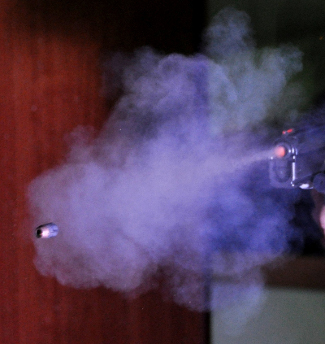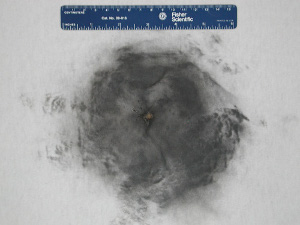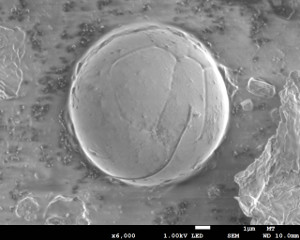Gunshot Residue Analysis (GSR)

The fine cloud of gunshot residue (GSR) from a pistol shot. (Photo by Niels Noordhoek, CC BY-SA 3.0)
Gunshot Residue Production and Analysis
Forensic investigations often rely on the evidence of gunshot and other firearms-related residues. When one fires a gun, the explosion creates a fine cloud of particles. These particles consist of burnt and unburnt powder, as well as traces from the bullet, its casing, and the gun itself. As the cloud settles, it lightly coats the area with gunshot residue (GSR). GSR will likely cling to the shooters hands, exposed skin, and clothing. Investigators usually sample this evidence with GSR test kit stubs. They can often obtain even more evidence from bullet-wipe deposits, partially burnt or unburnt powder, and trace materials on the bullet.

GSR on a T-shirt.
Microtrace’s experts test GSR and related residues using state-of-the-art analytical tools. Condensed particles of lead, antimony, and barium from the primer cap prove particularly useful for analytical purposes. The scientific community regards these “tri-component” particles as characteristic of a gunshot. Analyses typically begin with infrared photography and SEM analysis combined with energy dispersive X-ray spectroscopy (SEM/EDS). If a specific project calls for further analysis, our scientists can use advanced microchemical testing. When organic residue is present, it can be analyzed by gas chromatography and mass spectrometry (GC-MS).

A single tri-component particle by SEM.
GSR Case Reviews
Microtrace’s experts are routinely contacted to review the use of GSR in criminal court proceedings. Our reviews consist of a critical examination of all aspects of a case. This can include sample collection, analytical details, interpretation, and testimony. The typical one-page reports issued by most labs often omit vast amounts of important details. Context is especially important when evidence from a suspect tests positive for tri-component particles; they are not a definitive indicator that a suspect has fired a weapon. The suspect may have been in the area of a discharged weapon, but not fired the shot themselves. Furthermore, secondary transfer of GSR can contaminate a suspect. Perhaps they shook hands with or were handcuffed by someone who had fired a gun. In some cases, careful characterization of the entire population of trace (residue) particles (and their morphologies) may suggest alternate explanations for the presence of tri-component particles.
Gunshot Residue Submissions
Microtrace has been providing rigorous and scientifically-supported testing of GSR and providing expert testimony for more than 25 years. Our experience with gunshot residue analysis in a wide variety of environments has given us a unique and expert perspective when reviewing, testing, and retesting GSR for forensic purposes. Our experts conduct all work in our ISO 17025 accredited laboratory. We perform analyses in compliance with ASTM E1588- “Standard Guide for Gunshot Residue Analysis.”
Microtrace accepts and regularly analyzes commercial GSR test kits/collection kits. However, we specialize in unusual cases. We recognize that every investigation has its own sampling conditions and parameters. Because of this, our lab has developed the capabilities and expertise to accept a wide-variety of materials for testing and analysis. These include previously analyzed GSR collection kits/stubs, tape lifts, swabs, clothing, gloves, upholstery, window glass, and other substrates from the vicinity of a suspected discharged firearm.
Our laboratory’s standard turn-around-time is 10 business days. However, Rush options are also available.
Pricing available upon request.
Please contact us to discuss the specific needs of your project.
GSR Test Kits
Microtrace supplies GSR test kits to investigative agencies. A test kit contains 4 sample (SEM) stubs, a control stub, a pair of nitrile gloves, and a set of instructions. The cost for one kit is $15 and ten kits is $100. The cost of Microtrace GSR kits submitted to Microtrace for GSR analysis will be deducted from the analysis cost. Please contact us to order a GSR test kit.
Teaching GSR Analysis Techniques
Microtrace scientists have taught classes and given presentations on GSR testing and analysis throughout the world. Our scientists have presented on GSR to a wide variety of audiences from the Cook County Public Defender’s Seminar to the European Academy of Forensic Science (EAFS). Contact us to learn more about our gunshot residue courses.
Gunshot Residue Standardized Methods
ASTM (American Society for Testing and Materials) wrote a standardized guide for the analysis of GSR. E1588; “Standard Guide for Gunshot Residue Analysis by Scanning Electron Microscopy/Energy Dispersive Spectrometry.”
SWGGSR (Scientific Working Group for Gunshot Residue) was the precursor to OSAC/ASTM (above). However, this group also wrote their own standardized guide for GSR testing. “Guide for Primer Gunshot Residue Analysis by Scanning Electron Microscopy/Energy Dispersive X-Ray Spectrometry.” Download the guide here.
ENFSI (European Network of Forensic Science Institutes) working group on Firearms and GSR are working on a standardized guide for gunshot residue testing for European laboratories.
How May We Help You?
Contact usto discuss your project in more detail.







